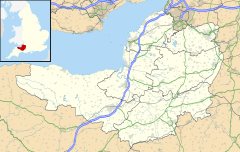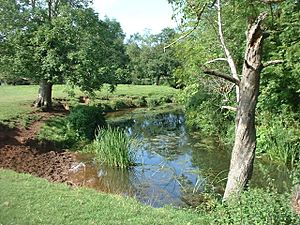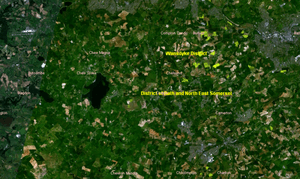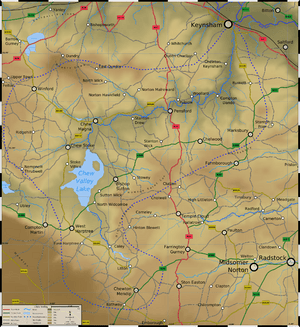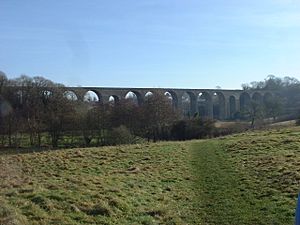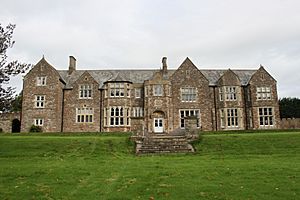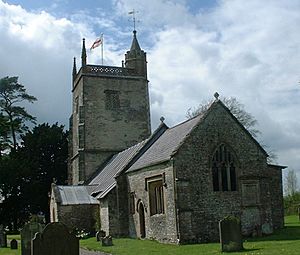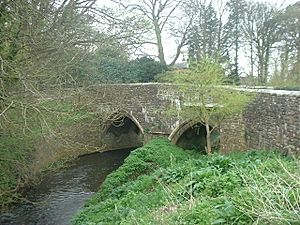Chew Valley facts for kids
Quick facts for kids Chew Valley |
|
|---|---|
| Area | 182 sq mi (470 km2) |
| Population | 5,000 |
| OS grid reference | ST571600 |
| District |
|
| Unitary authority | |
| Ceremonial county | |
| Region | |
| Country | England |
| Sovereign state | United Kingdom |
| Post town | BRISTOL |
| Postcode district | BS40 |
| Post town | RADSTOCK |
| Postcode district | BA3 |
| Dialling code | 01275 01761 |
| Police | Avon and Somerset |
| Fire | Avon |
| Ambulance | Great Western |
| EU Parliament | South West England |
| UK Parliament |
|
The Chew Valley is a beautiful area in North Somerset, England. It gets its name from the River Chew. This river starts at Chewton Mendip and flows into the River Avon at Keynsham. The valley is known for its rich farmland and many small villages.
The land in Chew Valley is mostly low and gently rolling. It is surrounded by higher areas like Dundry Down to the north and the Mendip Hills to the south. In the 1950s, the River Chew was dammed to create Chew Valley Lake. This lake provides drinking water for the city of Bristol and nearby towns. It's also a great spot for fun activities and is important for nature conservation. Many different birds, plants, and insects live here.
The Chew Valley is managed by councils like Bath and North East Somerset and North Somerset. Part of the area is even a special place called the Mendip Hills Area of Outstanding Natural Beauty. Many villages in the valley are very old, some dating back to the Domesday Book. People have lived here since the Stone Age. There are also hundreds of historic buildings, including churches that are hundreds of years old. The main town in the valley is Chew Magna.
Contents
What Does "Chew" Mean?
No one is completely sure where the name "Chew" comes from. It's a very unusual name! Some people think it means "winding water," with 'ew' being like the French word eau for water. Others believe it comes from an old English word chare, meaning "turning."
Another idea is that the name came from Normandy, France, as Cheux after the Norman Conquest. Some experts think it might come from the Welsh word cyw, which means "the young of an animal" or "chicken." So, afon Cyw could have meant "the river of the chickens." There's even a theory that it comes from an Old English word ceo, meaning "fish gill."
How the Valley is Governed
Each village in the Chew Valley has its own parish council. These councils handle local issues like parks and community events. People in the valley also vote for councillors who work for bigger councils. These bigger councils, like Bath and North East Somerset or North Somerset, are in charge of things like schools, rubbish collection, and tourism.
The villages are also part of larger areas that elect members to the UK Parliament. These areas are called North East Somerset or North Somerset. The Avon and Somerset Constabulary provides police services to keep everyone safe.
History of Chew Valley
How the Land Was Formed (Geology)
The land in Chew Valley has a very interesting history, shaped by different types of rocks and soil. In the western part, you'll find rocks like clay and limestone from the Jurassic period. The central part has older rocks from the Carboniferous period.
The soils here are generally well-drained. Around the lakes, the soil is a rich, silty clay, which is good for farming. This soil gets its reddish color from iron. The gently rolling hills of the valley are mostly made of red siltstone. There are also bands of sandstone that add to the wavy look of the land. Near the River Chew, you can find newer deposits of alluvial soil, which is carried by the river.
The edges of the valley, especially near the Mendip Hills, have steep slopes. These slopes are made of a rock called Dolomitic Conglomerate, which formed from desert erosion. It looks like concrete, made of rock pieces cemented together. The northern edge of the valley is formed by the Dundry Plateau, which has rocks from the Jurassic period. Some of these unique rock formations are protected as Sites of Special Scientific Interest (SSSIs).
The oldest rocks in the valley are from the Carboniferous period. These rocks contain coal seams, which were once part of the Somerset Coalfield. This area, especially around Pensford, used to be important for coal mining. The soils in these areas can be clayey and sometimes get waterlogged.
Plants and Animals (Natural History)
The Chew Valley is a special place for nature. Several areas are protected as SSSIs because of their important plants and animals. These include Blagdon Lake and Chew Valley Lake.
Plants (Flora)
The valley has many small and medium-sized fields. These fields are often separated by hedges and groups of trees. Some of these hedges are very old, dating back to when open fields were first divided up. These hedges are home to rare plants like the bithynian vetch.
You'll see many oak and ash trees here. Sometimes, you'll also spot scots pine and chestnut trees. Sadly, many elm trees in the area have been lost.
Animals (Fauna)
The Chew Valley is full of wildlife! It's especially famous for its water birds around the rivers and lakes. Chew Valley Lake is one of the most important places in Britain for birds that spend the winter there. You can see many types of ducks, shovellers, gadwalls, and great crested grebes.
Beyond water birds, many other bird species live here. These range from small birds like tits and wrens to larger ones like mistle thrushes, woodpeckers, and common buzzards.
The valley also has many small mammals. Larger animals include Eurasian badgers and deer. The Chew Valley is home to 15 of the 16 types of bats found in England! There's even a special place at Compton Martin Ochre Mine where greater horseshoe bats live. These bats are rare and protected by law.
People and Their History (Human Habitation)
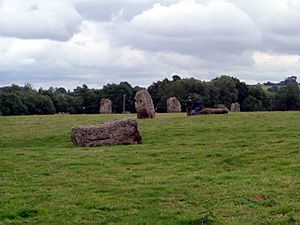
Before Chew Valley Lake was built, experts did archaeological digs. They found signs that people lived here during the Stone Age (Upper Palaeolithic, Mesolithic, and Neolithic periods). They found stone tools, flint blades, and even buildings and graves. Other ancient sites include the stone circle at Stanton Drew and the Fairy Toot burial mound. The Maes Knoll fort on Dundry Down is an Iron Age site.
There are also signs of Roman life, including a villa and burial sites. Roman items found here are now in museums. A collection of 11th-century coins, called the Chew Valley Hoard, was also discovered.
The valley has many historic houses, like Sutton Court and Chew Court. Most villages have churches that are hundreds of years old.
In the 1800s and early 1900s, the area around Pensford was important for coal mining. Even though there are no working mines today, you can still see the old Bristol and North Somerset Railway line. It crosses the River Chew on the impressive Pensford Viaduct. In 1968, the valley experienced serious flooding, especially around Pensford and Keynsham.
The small fields in the western part of the valley are very typical of the Chew Valley. Many of these fields were created in the late medieval period when large open areas were divided into smaller ones.
Weather in Chew Valley (Climate)
Like the rest of South West England, Chew Valley has a mild and often wet climate. The average yearly temperature is about 10°C (50°F). Temperatures don't change too much between seasons because the sea is nearby. July and August are the warmest months, with average high temperatures around 21°C (70°F). In winter, the average low temperatures are around 1°C (34°F) or 2°C (36°F).
The area gets about 700 millimeters (28 inches) of rain each year. Most of the rain in autumn and winter comes from storms moving in from the Atlantic Ocean. In summer, rain often comes from showers and thunderstorms caused by the sun heating the ground. Snowfall is typical for about 8 to 15 days a year. The wind is usually strongest from November to March and lightest from June to August.
Who Lives Here (Population and Demographics)
Many large houses in the valley were built by rich merchants from Bristol and Bath. They often hired local people to work for them. Famous people have lived here, too. Bess of Hardwick, a very powerful woman in the 1500s, lived at Sutton Court. The famous philosopher John Locke lived in Belluton in the 1600s.
In the past, many people worked in coal mining, but that's no longer the case. Today, there are still many people working in farming, light industry, or service jobs. Many residents also travel to nearby cities for work.
According to the 2011 Census, about 5,000 people live in the Chew Valley. Most live in the dozen or so villages or on isolated farms. The average age of people living here is 42. The area is considered one of the more wealthy parts of England.
Villages and Buildings
The villages in Chew Valley were often built where it was easy to cross rivers and streams. Chew Magna is the main business center, with shops and banks. Other villages have smaller local shops, often combined with post offices. Most villages also have pubs and village halls, which are important places for community events.
The buildings here are traditionally made from white Limestone, sometimes with red sandstone. Their roofs are usually made of red clay tiles. Many buildings, especially the churches, are hundreds of years old. For example, the church at Compton Martin has a special tower for pigeons!
Special Historic Buildings (Listed Buildings)
There are hundreds of listed buildings in the Chew Valley. A listed building is a structure that is officially recognized as being very important because of its history or special design. This protection helps make sure they are preserved.
Buildings are given different grades:
- Grade I: Buildings that are exceptionally important.
- Grade II*: Very important buildings of special interest.
- Grade II: Buildings of special interest.
In the Chew Valley, five churches dating back to the 14th century or even earlier have Grade I status. These include Church of St Andrew in Chew Magna and the Church of St Michael the Archangel in Compton Martin.
Getting Around (Transport)
The A38 and Bristol Airport are at the western end of the valley. This means some parts of the valley are under flight paths. The valley is also crossed by the A37 and A368. Most roads in the valley are small, quiet country lanes. However, Chew Magna can sometimes get busy.
A bus route called the "Chew Valley Explorer" (route 672/674) helps people get to the villages. Cyclists can enjoy the area using part of the West Country Way, which is National Cycle Network Route 3. The Monarch's Way, a long-distance walking path, also goes through the valley.
For train travel, Keynsham railway station is nearby. You can catch trains on the Great Western Main Line and Wessex Main Line. Buses also connect to Bristol Temple Meads train station.
Schools in the Valley
Chew Valley School is the main secondary school for students aged 11 to 18. It is located between Chew Magna and Chew Stoke. This school is very popular and has about 1,200 students. It has also won several awards. There are also state primary schools for younger children (4 to 11 years old) in most of the local villages.
Fun Things to Do (Sport and Leisure Facilities)
The villages in Chew Valley have football pitches and play areas for children. The Chew Valley Leisure Centre, located between Chew Magna and Chew Stoke, offers a gym, squash courts, badminton, and outdoor sports pitches.
There are many clubs and groups for all ages, including Scout groups and a gardening society. Some areas, like Burledge Hill and Knowle Hill, are open to the public for walking and exploring.
You can find a Bowls club in Chew Stoke, and cricket teams in Chew Magna and Blagdon. There are also football teams like Chew Valley Football Club and Bishop Sutton F.C.. The rugby club is next to the leisure center. Bishop Sutton Tennis club is the biggest in the valley.
Both Chew Valley Lake and Blagdon Lake are great for fishing, but you need a permit from Bristol Water. The River Chew also has fishing spots, usually managed by local clubs. Chew Valley Sailing Club on Chew Valley Lake offers dinghy sailing for all skill levels. While swimming isn't allowed in the lakes, you can find swimming pools in nearby Bristol, Bath, and Cheddar.
Every October, the Chew Valley Arts Trail takes place. Over 50 local artists show their work, including paintings, sculptures, and jewelry. The valley and its lakes have inspired many artists. You can even find a small art gallery at Chew Valley Lake. Local pubs and village halls often host live music and comedy events. The village of Pensford even has its own music festival every year!
|
See also
 In Spanish: Chew Valley para niños
In Spanish: Chew Valley para niños


